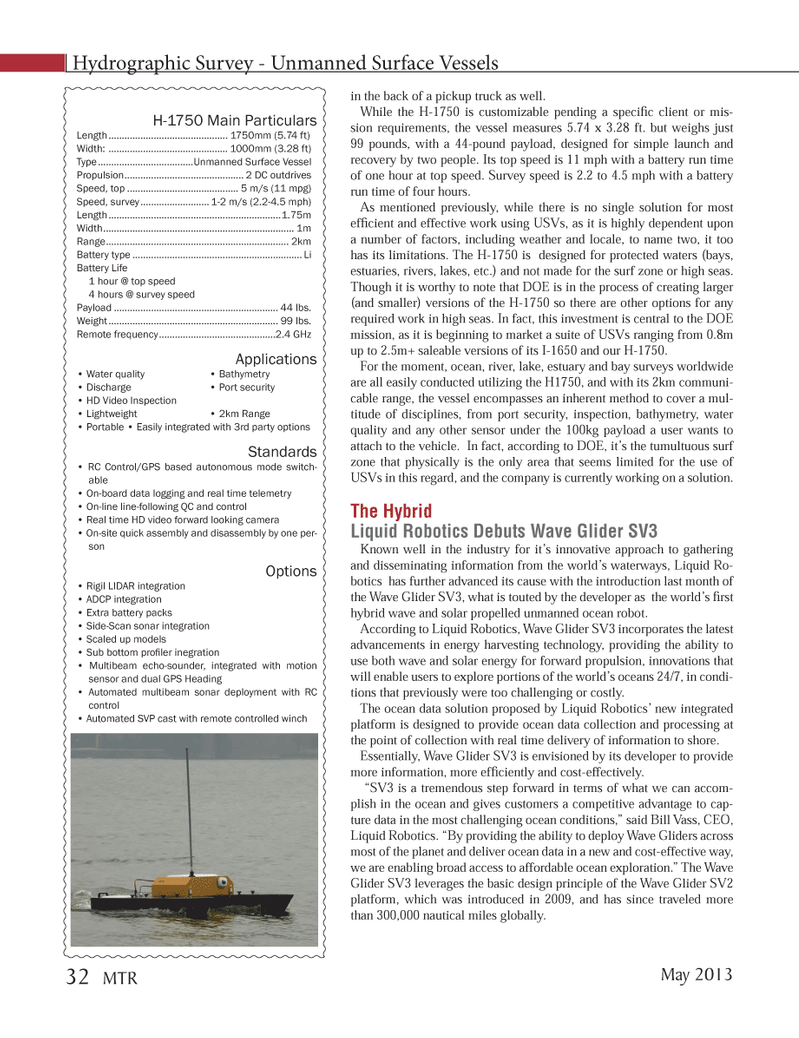
Page 32: of Marine Technology Magazine (May 2013)
Hydrographic Survey
Read this page in Pdf, Flash or Html5 edition of May 2013 Marine Technology Magazine
Hydrographic Survey - Unmanned Surface Vessels in the back of a pickup truck as well. While the H-1750 is customizable pending a speciÞ c client or mis- sion requirements, the vessel measures 5.74 x 3.28 ft. but weighs just 99 pounds, with a 44-pound payload, designed for simple launch and recovery by two people. Its top speed is 11 mph with a battery run time of one hour at top speed. Survey speed is 2.2 to 4.5 mph with a battery run time of four hours.As mentioned previously, while there is no single solution for most efÞ cient and effective work using USVs, as it is highly dependent upon a number of factors, including weather and locale, to name two, it too has its limitations. The H-1750 is designed for protected waters (bays, estuaries, rivers, lakes, etc.) and not made for the surf zone or high seas. Though it is worthy to note that DOE is in the process of creating larger (and smaller) versions of the H-1750 so there are other options for any required work in high seas. In fact, this investment is central to the DOE mission, as it is beginning to market a suite of USVs ranging from 0.8m up to 2.5m+ saleable versions of its I-1650 and our H-1750. For the moment, ocean, river, lake, estuary and bay surveys worldwide are all easily conducted utilizing the H1750, and with its 2km communi-cable range, the vessel encompasses an inherent method to cover a mul- titude of disciplines, from port security, inspection, bathymetry, water quality and any other sensor under the 100kg payload a user wants to attach to the vehicle. In fact, according to DOE, itÕs the tumultuous surf zone that physically is the only area that seems limited for the use of USVs in this regard, and the company is currently working on a solution. The HybridLiquid Robotics Debuts Wave Glider SV3 Known well in the industry for itÕs innovative approach to gathering and disseminating information from the worldÕs waterways, Liquid Ro- botics has further advanced its cause with the introduction last month of the Wave Glider SV3, what is touted by the developer as the worldÕs Þ rst hybrid wave and solar propelled unmanned ocean robot. According to Liquid Robotics, Wave Glider SV3 incorporates the latest advancements in energy harvesting technology, providing the ability to use both wave and solar energy for forward propulsion, innovations that will enable users to explore portions of the worldÕs oceans 24/7, in condi- tions that previously were too challenging or costly. The ocean data solution proposed by Liquid RoboticsÕ new integrated platform is designed to provide ocean data collection and processing at the point of collection with real time delivery of information to shore. Essentially, Wave Glider SV3 is envisioned by its developer to provide more information, more efÞ ciently and cost-effectively. ÒSV3 is a tremendous step forward in terms of what we can accom- plish in the ocean and gives customers a competitive advantage to cap- ture data in the most challenging ocean conditions,Ó said Bill Vass, CEO, Liquid Robotics. ÒBy providing the ability to deploy Wave Gliders across most of the planet and deliver ocean data in a new and cost-effective way, we are enabling broad access to affordable ocean exploration.Ó The Wave Glider SV3 leverages the basic design principle of the Wave Glider SV2 platform, which was introduced in 2009, and has since traveled more than 300,000 nautical miles globally. H-1750 Main Particulars Length .............................................1750mm (5.74 ft) Width: .............................................1000mm (3.28 ft) Type ....................................Unmanned Surface Vessel Propulsion .............................................2 DC outdrives Speed, top ..........................................5 m/s (11 mpg) Speed, survey ..........................1-2 m/s (2.2-4.5 mph) Length .................................................................1.75m Width ........................................................................1m Range .....................................................................2km Battery type ................................................................Li Battery Life 1 hour @ top speed 4 hours @ survey speed Payload ..............................................................44 lbs. Weight ................................................................99 lbs. Remote frequency ............................................2.4 GHz Applications? Water quality ? Bathymetry ? Discharge ? Port security ? HD Video Inspection? Lightweight ? 2km Range ? Portable ? Easily integrated with 3rd party options Standards ? RC Control/GPS based autonomous mode switch- able? On-board data logging and real time telemetry ? On-line line-following QC and control ? Real time HD video forward looking camera ? On-site quick assembly and disassembly by one per- sonOptions? Rigil LIDAR integration ? ADCP integration ? Extra battery packs ? Side-Scan sonar integration ? Scaled up models? Sub bottom pro Þ ler inegration ? Multibeam echo-sounder, integrated with motion sensor and dual GPS Heading? Automated multibeam sonar deployment with RC control ? Automated SVP cast with remote controlled winch 32 MTRMay 2013MTR #4 (18-33).indd 32MTR #4 (18-33).indd 325/6/2013 10:56:49 AM5/6/2013 10:56:49 AM

 31
31

 33
33
